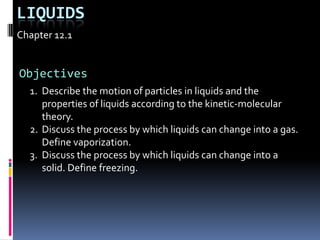Chapter 12.1 : Liquids
•Als PPTX, PDF herunterladen•
2 gefällt mir•1,031 views
Melden
Teilen
Melden
Teilen

Empfohlen
Weitere ähnliche Inhalte
Was ist angesagt?
Was ist angesagt? (20)
Andere mochten auch
Andere mochten auch (20)
Introduction to Science 3.1 : Exploring Physical Science

Introduction to Science 3.1 : Exploring Physical Science
Ähnlich wie Chapter 12.1 : Liquids
Ähnlich wie Chapter 12.1 : Liquids (20)
Chapter 1 kinetic particle theory notes ( class test )

Chapter 1 kinetic particle theory notes ( class test )
Mehr von Chris Foltz
Mehr von Chris Foltz (20)
Earth Science 3.3 : Absolute Dating: A Measure of Time

Earth Science 3.3 : Absolute Dating: A Measure of Time
Earth Science 3.1 : Earth's Story and Those Who First Listened.

Earth Science 3.1 : Earth's Story and Those Who First Listened.
Earth Science 3.2 : Relative Dating : Which Came First?

Earth Science 3.2 : Relative Dating : Which Came First?
Kürzlich hochgeladen
APM Welcome, APM North West Network Conference, Synergies Across Sectors

APM Welcome, APM North West Network Conference, Synergies Across SectorsAssociation for Project Management
Kürzlich hochgeladen (20)
Beyond the EU: DORA and NIS 2 Directive's Global Impact

Beyond the EU: DORA and NIS 2 Directive's Global Impact
APM Welcome, APM North West Network Conference, Synergies Across Sectors

APM Welcome, APM North West Network Conference, Synergies Across Sectors
Web & Social Media Analytics Previous Year Question Paper.pdf

Web & Social Media Analytics Previous Year Question Paper.pdf
Presentation by Andreas Schleicher Tackling the School Absenteeism Crisis 30 ...

Presentation by Andreas Schleicher Tackling the School Absenteeism Crisis 30 ...
Disha NEET Physics Guide for classes 11 and 12.pdf

Disha NEET Physics Guide for classes 11 and 12.pdf
Chapter 12.1 : Liquids
- 1. Liquids Chapter 12.1 Objectives Describe the motion of particles in liquids and the properties of liquids according to the kinetic-molecular theory. Discuss the process by which liquids can change into a gas. Define vaporization. Discuss the process by which liquids can change into a solid. Define freezing.
- 2. Liquids Examples: Oceans, lakes, rivers Hard to believe – liquids are the least common state in the universe Why? Narrow temperature range they can exist in!
- 3. Properties of Liquids and Kinetic-Molecular Theory Definite volume, take shape of container According to Kinetic-Molecular Theory Liquid’s particles are: In constant random motion Closer together than gases, there are attractive forces More ordered than gases, so particles are held together, but do have mobility. Fluid: substance that can flow and therefore take the shape of its container
- 4. Relatively High Density Thousands of times denser than gases Slightly less dense than solids Due to the close arrangement of liquid particles
- 6. Constant, random motion of particles
- 8. Evaporation and Boiling Vaporization: Process by which a liquid or solid changes to a gas Evaporation: Process by which particles escape from the surface of a non-boiling liquid and enter the gas state. Boiling: Change in liquid to bubbles of vapor that appear throughout the liquid.
- 9. Formation of Solids When liquid is cooled, average kinetic energy decreases Particles slow down Attractive forces pull into an orderly arrangement Freezing (solidification): Physical change of a liquid to a solid by removal of heat.